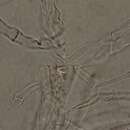en
names in breadcrumbs


Small, usually subglobose to broadly ellipsoid partial-population dextrinoid spores.
Pileipellis a cutis
Often lilac to purple basidiomes.
Alkaline-virescent reactions in some taxa (green in KOH or Ammonia)
Absence of pleurocystidia.
Europe, Peru, United States of America, Jamaica
Quite small, basidiomes often lilac to purple, also brown or yellow or more rarely white.
Pilei dry, smooth to slightly granular, sometimes with an inflexed or crenate margin, usually not hygrophanous or rarely so at margin.
Lamellae variable, often concolorous with pileus or duller, dull yellow brown to grey, or darker brown to purple. Usually attached, adnate to adnexed but also frequently emarginate or more rarely even free. Usually thin, simple, and close to relatively well-spaced; but in at least two cases thicker and/or transvenose / intervenose.
Stipe ranging from short and thick to filiform (very tall and thin). Often similar to pileus in color or duller. Solid or hollow. Often with distinct granular scurfy apex or punctations, also often basal tomentum or mycelial aggregates.
Macrochemical reactions often important – can show grass-green or blue reactions with application of KOH or other alkaline reagents. This is an important taxonomic character.
Pileipellis a cutis of thin to inflated hyphae, or more rarely an irregular near-trichoderm. Often with a suprapellis over a subpellis of broader, shorter hyphae. The presence or absence of a two layered pilepellis is an important taxonomic character. Pigmentation in KOH purple, purple changing to green, yellowish-brown, red fading to yellowish green, this character is taxonomically important.
Lamellar trama usually subregular, often with inflated barrel shaped, clamped hyphae with slightly thickened walls.
Basidia of a typical clavate shape, usually 4-spored but also with 2-spored cells occasionally.
Pleurocystidia not present in any member of the genus.
Cheilocystidia present in some members, of high taxonomic value.
Spores quite small (2.8 – 6 microns), usually with a partial population of dextrinoid spores, often globose to subglobose to broadly ellipsoidbut also sometimes distinctly ellipsoid. Size and shape taxonomically valuable, but subtly in differentiation.
Caulocystidia present at least at apex of stipe, polymorphic and often quite irregular, but in some taxa consistently cylindrical or irregularly cylindrical.
Saprotrophic in a wide variety of habitats.
Gymnopus – Pileipellis often a more tangled cutis of sometimes encrusted hyphae. Spores larger, inamyloid or v. weakly so, usually with browner basidiocarps that are often slightly larger.
Laccaria – With inamyloid, globose, echinate to echinulate, larger spores. Gills usually thicker and venose and very widely spaced. Pigments of basidiocarps often more distinctly purple or more pink. Basidiocarps usually larger, sometimes much larger, fleshier, and tough-fibrous.
Rhodocollybia – pileipellis an ixocutis, spores also partially dextrinoid, but usually not so globose and larger, basidiocarps not purple or lilac.
Callistosporium – spores larger, ellipsoid, and those of dessicata with reddish necropigments (also in basidia?). This genus may be closely related to Pseudobaeospora.
Pseudobaeospora is a genus of fungi in the family Tricholomataceae.[1] A 2008 estimate placed about 20 species in the widespread genus.[2]
Pseudobaeospora is a genus of fungi in the family Tricholomataceae. A 2008 estimate placed about 20 species in the widespread genus.